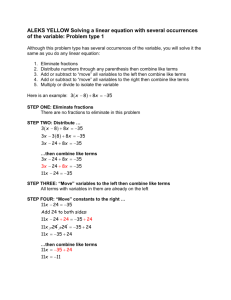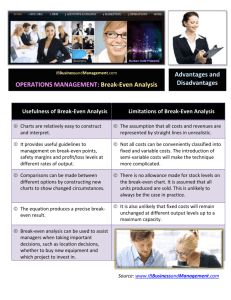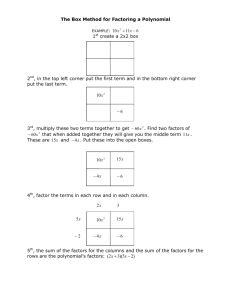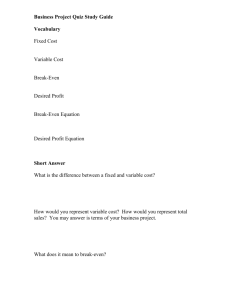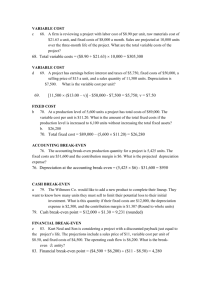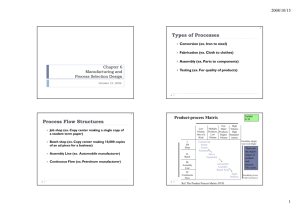Section 6.4, Example 3
advertisement
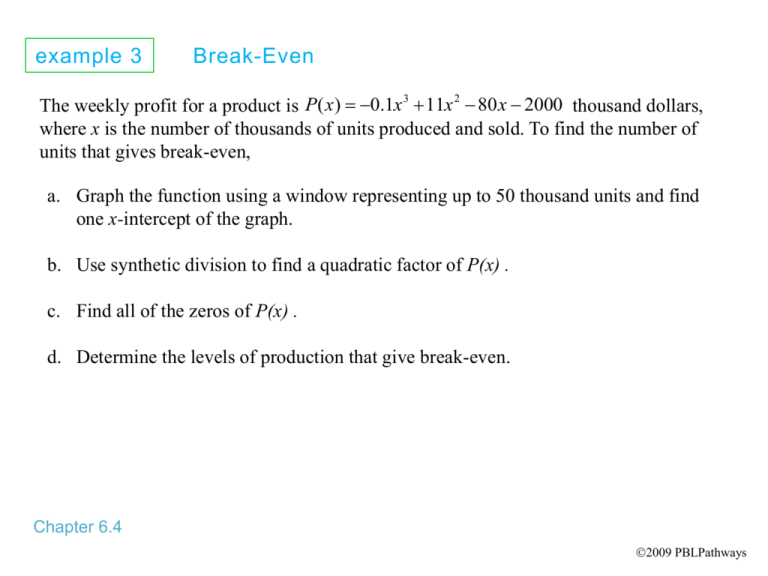
example 3 Break-Even 3 2 The weekly profit for a product is P( x) 0.1x 11x 80 x 2000 thousand dollars, where x is the number of thousands of units produced and sold. To find the number of units that gives break-even, a. Graph the function using a window representing up to 50 thousand units and find one x-intercept of the graph. b. Use synthetic division to find a quadratic factor of P(x) . c. Find all of the zeros of P(x) . d. Determine the levels of production that give break-even. Chapter 6.4 2009 PBLPathways 3 2 The weekly profit for a product is P( x) 0.1x 11x 80 x 2000 thousand dollars, where x is the number of thousands of units produced and sold. To find the number of units that gives break-even, a. Graph the function using a window representing up to 50 thousand units and find one x-intercept of the graph. b. Use synthetic division to find a quadratic factor of P(x) . c. Find all of the zeros of P(x) . d. Determine the levels of production that give break-even. 2009 PBLPathways 3 2 The weekly profit for a product is P( x) 0.1x 11x 80 x 2000 thousand dollars, where x is the number of thousands of units produced and sold. To find the number of units that gives break-even, a. Graph the function using a window representing up to 50 thousand units and find one x-intercept of the graph. 0 0.1x3 11x 2 80 x 2000 P(x) (20, 0) x 2009 PBLPathways 3 2 The weekly profit for a product is P( x) 0.1x 11x 80 x 2000 thousand dollars, where x is the number of thousands of units produced and sold. To find the number of units that gives break-even, a. Graph the function using a window representing up to 50 thousand units and find one x-intercept of the graph. 0 0.1x3 11x 2 80 x 2000 P(x) (20, 0) x 2009 PBLPathways 3 2 The weekly profit for a product is P( x) 0.1x 11x 80 x 2000 thousand dollars, where x is the number of thousands of units produced and sold. To find the number of units that gives break-even, a. Graph the function using a window representing up to 50 thousand units and find one x-intercept of the graph. 0 0.1x3 11x 2 80 x 2000 P(x) x 2009 PBLPathways 3 2 The weekly profit for a product is P( x) 0.1x 11x 80 x 2000 thousand dollars, where x is the number of thousands of units produced and sold. To find the number of units that gives break-even, a. Graph the function using a window representing up to 50 thousand units and find one x-intercept of the graph. 0 0.1x3 11x 2 80 x 2000 P(x) (20, 0) x 2009 PBLPathways 3 2 The weekly profit for a product is P( x) 0.1x 11x 80 x 2000 thousand dollars, where x is the number of thousands of units produced and sold. To find the number of units that gives break-even, b. Use synthetic division to find a quadratic factor of P(x) . 1. Arrange the coefficients in descending powers of x, with a 0 for any missing power. Place a from x - a to the left of the coefficients. 20 0.1 11 80 2000 2 180 2000 0.1 9 100 0 2009 PBLPathways 3 2 The weekly profit for a product is P( x) 0.1x 11x 80 x 2000 thousand dollars, where x is the number of thousands of units produced and sold. To find the number of units that gives break-even, b. Use synthetic division to find a quadratic factor of P(x) . 1. Arrange the coefficients in descending powers of x, with a 0 for any missing power. Place a from x - a to the left of the coefficients. 20 0.1 11 80 2000 2 180 2000 0.1 9 100 0 2009 PBLPathways 3 2 The weekly profit for a product is P( x) 0.1x 11x 80 x 2000 thousand dollars, where x is the number of thousands of units produced and sold. To find the number of units that gives break-even, b. Use synthetic division to find a quadratic factor of P(x) . 2. Bring down the first coefficient to the third line. Multiply the last number in the third line by a and write the product in the second line under the next term. 20 0.1 11 80 2000 2 180 2000 0.1 9 100 0 2009 PBLPathways 3 2 The weekly profit for a product is P( x) 0.1x 11x 80 x 2000 thousand dollars, where x is the number of thousands of units produced and sold. To find the number of units that gives break-even, b. Use synthetic division to find a quadratic factor of P(x) . 2. Bring down the first coefficient to the third line. Multiply the last number in the third line by a and write the product in the second line under the next term. 20 0.1 11 80 2000 2 180 2000 Multiply 0.1 9 100 0 2009 PBLPathways 3 2 The weekly profit for a product is P( x) 0.1x 11x 80 x 2000 thousand dollars, where x is the number of thousands of units produced and sold. To find the number of units that gives break-even, b. Use synthetic division to find a quadratic factor of P(x) . 3. Add the last number in the second line to the number above it in the first line. Continue this process until all numbers in the first line are used. 20 0.1 11 80 2000 2 180 2000 0.1 9 100 0 2009 PBLPathways 3 2 The weekly profit for a product is P( x) 0.1x 11x 80 x 2000 thousand dollars, where x is the number of thousands of units produced and sold. To find the number of units that gives break-even, b. Use synthetic division to find a quadratic factor of P(x) . 3. Add the last number in the second line to the number above it in the first line. Continue this process until all numbers in the first line are used. 20 0.1 11 80 2000 2 180 2000 0.1 9 100 0 2009 PBLPathways 3 2 The weekly profit for a product is P( x) 0.1x 11x 80 x 2000 thousand dollars, where x is the number of thousands of units produced and sold. To find the number of units that gives break-even, b. Use synthetic division to find a quadratic factor of P(x) . 3. Add the last number in the second line to the number above it in the first line. Continue this process until all numbers in the first line are used. 20 0.1 11 80 2000 2 180 2000 0.1 9 100 0 2009 PBLPathways 3 2 The weekly profit for a product is P( x) 0.1x 11x 80 x 2000 thousand dollars, where x is the number of thousands of units produced and sold. To find the number of units that gives break-even, b. Use synthetic division to find a quadratic factor of P(x) . 3. Add the last number in the second line to the number above it in the first line. Continue this process until all numbers in the first line are used. 20 0.1 11 80 2000 2 180 2000 0.1 9 100 0 2009 PBLPathways 3 2 The weekly profit for a product is P( x) 0.1x 11x 80 x 2000 thousand dollars, where x is the number of thousands of units produced and sold. To find the number of units that gives break-even, b. Use synthetic division to find a quadratic factor of P(x) . 3. Add the last number in the second line to the number above it in the first line. Continue this process until all numbers in the first line are used. 20 0.1 11 80 2000 2 180 2000 0.1 9 100 0 2009 PBLPathways 3 2 The weekly profit for a product is P( x) 0.1x 11x 80 x 2000 thousand dollars, where x is the number of thousands of units produced and sold. To find the number of units that gives break-even, b. Use synthetic division to find a quadratic factor of P(x) . 4. The third line represents the coefficients of the quotient, with the last number the remainder. The quotient is a polynomial of degree one less than the dividend. 20 0.1 11 80 2000 2 180 2000 0.1 9 100 Coefficients of quotient 0 Remainder 2009 PBLPathways 3 2 The weekly profit for a product is P( x) 0.1x 11x 80 x 2000 thousand dollars, where x is the number of thousands of units produced and sold. To find the number of units that gives break-even, b. Use synthetic division to find a quadratic factor of P(x) . 4. If the remainder is 0, x – a is a factor of the polynomial, and the polynomial can be written as the product of the divisor x - a and the quotient. 0.1x3 11x 2 80 x 2000 x 20 0.1x 2 9 x 100 20 0.1 11 80 2000 2 180 2000 0.1 9 100 Coefficients of quotient 0 Remainder 2009 PBLPathways 3 2 The weekly profit for a product is P( x) 0.1x 11x 80 x 2000 thousand dollars, where x is the number of thousands of units produced and sold. To find the number of units that gives break-even, c. Find all of the zeros of P(x) . 0.1x 3 11x 2 80 x 2000 0 x 20 0.1x 2 9 x 100 0 x 20 0.1 x 2 90 x 1000 0 0.1 x 20 x 100 x 10 0 x 20 0 or x 20 x 100 0 or x 100 x 10 0 x 10 2009 PBLPathways 3 2 The weekly profit for a product is P( x) 0.1x 11x 80 x 2000 thousand dollars, where x is the number of thousands of units produced and sold. To find the number of units that gives break-even, c. Find all of the zeros of P(x) . 0.1x 3 11x 2 80 x 2000 0 x 20 0.1x 2 9 x 100 0 x 20 0.1 x 2 90 x 1000 0 0.1 x 20 x 100 x 10 0 x 20 0 or x 20 x 100 0 or x 100 x 10 0 x 10 2009 PBLPathways 3 2 The weekly profit for a product is P( x) 0.1x 11x 80 x 2000 thousand dollars, where x is the number of thousands of units produced and sold. To find the number of units that gives break-even, c. Find all of the zeros of P(x) . 0.1x 3 11x 2 80 x 2000 0 x 20 0.1x 2 9 x 100 0 x 20 0.1 x 2 90 x 1000 0 0.1 x 20 x 100 x 10 0 x 20 0 or x 20 x 100 0 or x 100 x 10 0 x 10 2009 PBLPathways 3 2 The weekly profit for a product is P( x) 0.1x 11x 80 x 2000 thousand dollars, where x is the number of thousands of units produced and sold. To find the number of units that gives break-even, c. Find all of the zeros of P(x) . 0.1x 3 11x 2 80 x 2000 0 x 20 0.1x 2 9 x 100 0 x 20 0.1 x 2 90 x 1000 0 0.1 x 20 x 100 x 10 0 x 20 0 or x 20 x 100 0 or x 100 x 10 0 x 10 2009 PBLPathways 3 2 The weekly profit for a product is P( x) 0.1x 11x 80 x 2000 thousand dollars, where x is the number of thousands of units produced and sold. To find the number of units that gives break-even, c. Find all of the zeros of P(x) . 0.1x 3 11x 2 80 x 2000 0 x 20 0.1x 2 9 x 100 0 x 20 0.1 x 2 90 x 1000 0 0.1 x 20 x 100 x 10 0 x 20 0 or x 20 x 100 0 or x 100 x 10 0 x 10 2009 PBLPathways 3 2 The weekly profit for a product is P( x) 0.1x 11x 80 x 2000 thousand dollars, where x is the number of thousands of units produced and sold. To find the number of units that gives break-even, c. Find all of the zeros of P(x) . 0.1x 3 11x 2 80 x 2000 0 x 20 0.1x 2 9 x 100 0 x 20 0.1 x 2 90 x 1000 0 0.1 x 20 x 100 x 10 0 x 20 0 or x 20 x 100 0 or x 100 x 10 0 x 10 2009 PBLPathways 3 2 The weekly profit for a product is P( x) 0.1x 11x 80 x 2000 thousand dollars, where x is the number of thousands of units produced and sold. To find the number of units that gives break-even, d. Determine the levels of production that give break-even. P(x) (-10,0) (20,0) (100,0) x 2009 PBLPathways 3 2 The weekly profit for a product is P( x) 0.1x 11x 80 x 2000 thousand dollars, where x is the number of thousands of units produced and sold. To find the number of units that gives break-even, d. Determine the levels of production that give break-even. P(x) (-10,0) (20,0) (100,0) x Break-even points 2009 PBLPathways

